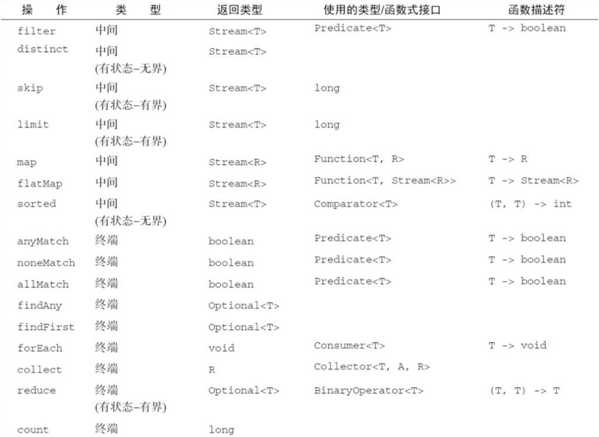标签:sts 成员 type 合并 tst long list 基本 java
流是Java API的新成员,它允许以声明性方式处理数据集合(通过查询语句来表达,而不是临时编写一个实现)。就现在来说,可以把它们看成遍历数据集的高级迭代器。此外,流还可以透明地并行处理,无需写任何多线程代码了!
流的使用一般包括三件事:
•一个数据源(如集合)来执行一个查询;
•一个中间操作链,形成一条流的流水线;
•一个终端操作,执行流水线,并能生成结果。
|
流方法 |
含义 |
示例 |
|
filter |
(中间操作)该操作会接受一个谓词(一个返回boolean的函数)作为参数,并返回一个包括所有符合谓词的元素的流。 |
List<Dish> vegetarianMenu = menu.stream() .filter(Dish::isVegetarian) .collect(toList()); System.out.println(vegetarianMenu); |
|
distinct |
(中间操作)返回一个元素各异(根据流所生成元素的hashCode和equals方法实现)的流。 |
List<Integer> numbers = Arrays.asList(1, 2, 1, 3, 3, 2, 4); numbers.stream() .filter(i -> i % 2 == 0) .distinct() .forEach(System.out::println); |
|
limit |
(中间操作)会返回一个不超过给定长度的流。 |
List<Dish> dishes = menu.stream() .filter(d -> d.getCalories() > 300) .limit(3) .collect(toList()); System.out.println(dishes); |
|
skip |
(中间操作)返回一个扔掉了前n个元素的流。 |
List<Dish> dishes = menu.stream() .filter(d -> d.getCalories() > 300) .skip(2) .collect(toList()); System.out.println(dishes); |
|
map |
(中间操作)接受一个函数作为参数。这个函数会被应用到每个元素上,并将其映射成一个新的元素(使用映射一词,是因为它和转换类似,但其中的细微差别在于它是“创建一个新版本”而不是去“修改”)。 |
List<String> dishNames = menu.stream() .map(Dish::getName) .collect(toList()); System.out.println(dishNames); |
|
flatMap |
(中间操作)使用flatMap方法的效果是,各个数组并不是分别映射成一个流,而是映射成流的内容。所有使用map(Arrays::stream)时生成的单个流都被合并起来,即扁平化为一个流。 |
List<String> words = Arrays.asList("Goodbye", "World"); List<String> uniqueCharacters = words.stream() .map(w -> w.split("")) .flatMap(Arrays::stream) .distinct() .collect(Collectors.toList()); System.out.println(uniqueCharacters); |
|
sorted |
(中间操作)返回排序后的流 |
List<String> traderStr = menu.stream() .map(transaction -> transaction.getName()) .sorted() .collect(toList()); System.out.println(traderStr); |
|
anyMatch |
(终端操作)可以回答“流中是否有一个元素能匹配给定的谓词”。 |
if (menu.stream().anyMatch(Dish::isVegetarian)) { System.out.println("The menu is (somewhat) vegetarian friendly!!"); } |
|
allMatch |
(终端操作)会看看流中的元素是否都能匹配给定的谓词。 |
boolean isHealthy = menu.stream() .allMatch(d -> d.getCalories() < 1000); System.out.println(isHealthy); |
|
noneMatch |
(终端操作)可以确保流中没有任何元素与给定的谓词匹配。 |
boolean isHealthy = menu.stream() .noneMatch(d -> d.getCalories() >= 1000); System.out.println(isHealthy); |
|
findAny |
(终端操作)将返回当前流中的任意元素。 |
Optional<Dish> dish = menu.stream() .filter(Dish::isVegetarian) .findAny(); System.out.println(dish); |
|
findFirst |
(终端操作)有些流有一个出现顺序(encounter order)来指定流中项目出现的逻辑顺序(比如由List或排序好的数据列生成的流)。对于这种流,可能想要找到第一个元素。 |
List<Integer> someNumbers = Arrays.asList(1, 2, 3, 4, 5); Optional<Integer> firstSquareDivisibleByThree = someNumbers.stream() .map(x -> x * x) .filter(x -> x % 3 == 0) .findFirst(); System.out.println(firstSquareDivisibleByThree); |
|
forEach |
(终端操作)遍历流 |
List<Integer> numbers = Arrays.asList(1, 2, 1, 3, 3, 2, 4); numbers.stream() .filter(i -> i % 2 == 0) .distinct() .forEach(System.out::println); |
|
collect |
(终端操作)收集器 |
List<String> traderStr = menu.stream() .map(transaction -> transaction.getName()) .sorted() .collect(toList()); |
|
reduce |
(终端操作)归约reduce接受两个参数: •一个初始值,这里是0; •一个BinaryOperator<T>来将两个元素结合起来产生一个新值,这里我们用的是lambda (a, b) -> a + b。 |
List<Integer> numbers = Arrays.asList(1, 2, 1, 3, 3, 2, 4); int sum = numbers.stream().reduce(0, (a, b) -> a + b); System.out.println(sum); |
|
count |
(终端操作)返回此流中元素的计数。 |
long evenNumbers = IntStream.rangeClosed(1, 100) .filter(n -> n % 2 == 0) .count(); System.out.println(evenNumbers); |

•可以使用filter、distinct、skip和limit对流做筛选和切片。
•可以使用map和flatMap提取或转换流中的元素。
•可以使用findFirst和findAny方法查找流中的元素。可以用allMatch、noneMatch和anyMatch方法让流匹配给定的谓词。
•这些方法都利用了短路:找到结果就立即停止计算;没有必要处理整个流。
•可以利用reduce方法将流中所有的元素迭代合并成一个结果,例如求和或查找最大元素。
•filter和map等操作是无状态的,它们并不存储任何状态。reduce等操作要存储状态才能计算出一个值。sorted和distinct等操作也要存储状态,因为它们需要把流中的所有元素缓存起来才能返回一个新的流。这种操作称为有状态操作。
•流有三种基本的原始类型特化:IntStream、DoubleStream和LongStream。它们的操作也有相应的特化。
•流不仅可以从集合创建,也可从值、数组、文件以及iterate与generate等特定方法创建。
•无限流是没有固定大小的流。
附:示例中用到的类
package lambdasinaction.chap4; import java.util.*; public class Dish { private final String name; private final boolean vegetarian; private final int calories; private final Type type; public Dish(String name, boolean vegetarian, int calories, Type type) { this.name = name; this.vegetarian = vegetarian; this.calories = calories; this.type = type; } public String getName() { return name; } public boolean isVegetarian() { return vegetarian; } public int getCalories() { return calories; } public Type getType() { return type; } public enum Type { MEAT, FISH, OTHER } @Override public String toString() { return name; } public static final List<Dish> menu = Arrays.asList( new Dish("pork", false, 800, Dish.Type.MEAT), new Dish("beef", false, 700, Dish.Type.MEAT), new Dish("chicken", false, 400, Dish.Type.MEAT), new Dish("french fries", true, 530, Dish.Type.OTHER), new Dish("rice", true, 350, Dish.Type.OTHER), new Dish("season fruit", true, 120, Dish.Type.OTHER), new Dish("pizza", true, 550, Dish.Type.OTHER), new Dish("prawns", false, 400, Dish.Type.FISH), new Dish("salmon", false, 450, Dish.Type.FISH)); }
参考:java8实战
标签:sts 成员 type 合并 tst long list 基本 java
原文地址:https://www.cnblogs.com/ooo0/p/11439432.html